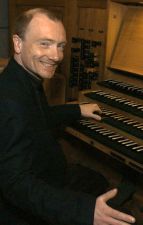Heßler & Organ
»A perennial favorite of church music.« (Wicho Herrmann-Kümper, Unsere Kirche, Nr. 9, 23. Februar 2014, S. 18).
»The Multi-Talented« (Neues Ruhr-Wort, 8. Oktober 2016).
»With his star seconds he made the venerable Faust organ of the Paulus church Hüls shine.« (Jürgen Wolter, WAZ, 18.12.2013).
»The audience was enthusiastic.« (RP, 19.08.11).
»How he drums with his right hand on various percussion instruments, while the left hand and feet use the organ is certainly impressive.« (Rudolf Hermes, WAZ Duisburg, 8. August 2014).
»It offered [...] a concert experience beyond the usual repertoire paths« (Gerd-Heinz Stevens, WAZ, 20.04.15).
»[Hans-Joachim Heßler] opened […] the concert with his own Variatio on the advent chorale "A ship is coming laden", using medieval modality and the rhythm of the Sarabande […], linking it all together in a stylistically skillful way. […] In a meditation on "How lovely shines the morning star" he made the morning star sparkle with veritable sound cascades …« (Malte Hemmerich in der WAZ Herne vom 3. Dezember 2012).
»The day of the open monument in St. Pauls Church (Marl-Hüls) was also about the Faust organ from 1914. It has been landmarked since the mid-80s and completely restored since 1987 - in the original, late-romantic sound in which the famous organ builder Paul Faust from Schwelm […] built his (pneumatic) organs. […] The Dortmund organist Joachim Weiß […] let wonderful sound paintings emerge from the melodius and colorful compositions. Using the tumescent dynamic possibilities of the organ Weiß interpreted [Hans-]Joachim Heßlers "Irritations" and "Nabuli Tintin" in an equally memorable way.« (Marler Zeitung, 10.10.1999)
»Hans-Joachim Heßlers meditative conjuration of the divine spark "Evocation No. 2" presented further facets of contemporary music« (Westfälischer Anzeiger, 04.08.2009).
»Dome music in Letmathe […] The afternoon followed the motto "Sound Clouds", a concert for percussion and organ. In the musical landscape, this combination is quite unusual. Martin Brödemann (organ) and Sarkis Cat (percussion) performed pieces by contemporary composers as well as their own compositions. […] Martin Brödemann and Sarkis Cat harmonized perfectly with one another, giving each piece their own unique twist, with especially Martin Brödemann using the sound diversity of the organ to its fullest. Sometimes nuanced as in "Toccata minimal", sometimes effervescent and raging as in "Homage to Claude Debussy" [by Hans-Joachim He▀ler]. The audience listened to the unconventional compositions with fascination.«(Der Westen, 22.03.2010).
»"A.C.D.E.B.": The initials of the French impressionist provided the tone sequence being repeated in variations in Hans-Joachim Heßler's "Homage to Achille-Claude Debussy"« (Westfälischer Anzeiger, 24.10.2010).
»The unusual duo [Cat/Brödemann] makes one sit up and take notice: the combination of church organ with its light and dark registers and timbres with oriental percussion instruments opens up new worlds of sound, combining old forms and rhythmic structures to completely new sound experiences.[…] The "Homage to Achille-Claude Debussy" by Hans-Joachim Heßler underlines this specific impressionistic sound with dark organ colors and Southeast Asian singing bowls and gongs« (WAZ, 28.05.2012).
»The zodiac signs as short organ impressions - brightly lit, then disappearing quickly - transform Heßler's shooting star idea into sound. The wide spectrum ranged from the ringing jumps of the Aries to the gurgling bubbling of organ-Pisces. […] Finally Heßler ended the concert with his own "Per Paertuum Mobile" in a fulminantly successful finale. […] Arvo Pärt's preoccupation with medieval music was the inspiration for this minimalist-meditative composition.« (Westfälischer Anzeiger, 21.08.2012).


